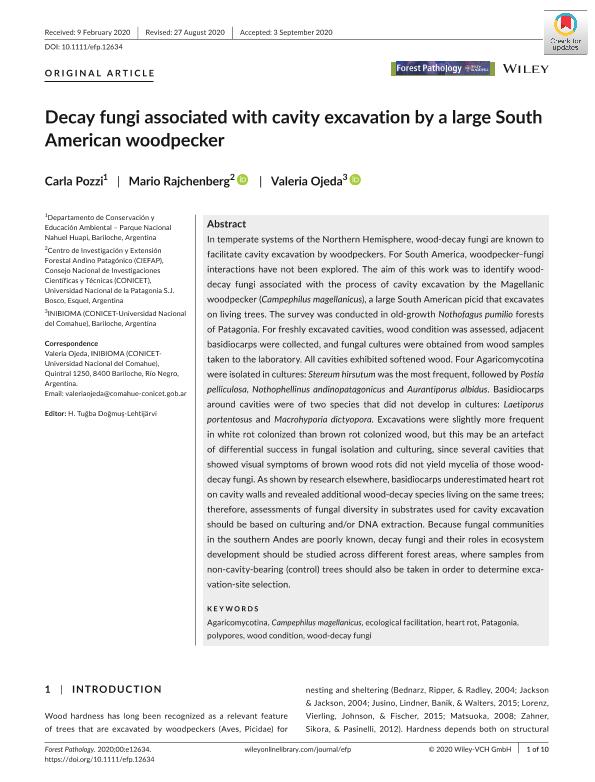Artículo
Decay fungi associated with cavity excavation by a large South American woodpecker
Fecha de publicación:
10/2020
Editorial:
Wiley Blackwell Publishing, Inc
Revista:
Forest Pathology
ISSN:
1437-4781
e-ISSN:
1478-6427
Idioma:
Inglés
Tipo de recurso:
Artículo publicado
Clasificación temática:
Resumen
In temperate systems of the Northern Hemisphere, wood-decay fungi are known to facilitate cavity excavation by woodpeckers. For South America, woodpecker–fungi interactions have not been explored. The aim of this work was to identify wooddecay fungi associated with the process of cavity excavation by the Magellanic woodpecker (Campephilus magellanicus), a large South American picid that excavates on living trees. The survey was conducted in old-growth Nothofagus pumilio forests of Patagonia. For freshly excavated cavities, wood condition was assessed, adjacent basidiocarps were collected, and fungal cultures were obtained from wood samples taken to the laboratory. All cavities exhibited softened wood. Four Agaricomycotina were isolated in cultures: Stereum hirsutum was the most frequent, followed by Postia pelliculosa, Nothophellinus andinopatagonicus and Aurantiporus albidus. Basidiocarps around cavities were of two species that did not develop in cultures: Laetiporus portentosus and Macrohyporia dictyopora. Excavations were slightly more frequent in white rot colonized than brown rot colonized wood, but this may be an artefact of differential success in fungal isolation and culturing, since several cavities that showed visual symptoms of brown wood rots did not yield mycelia of those wooddecay fungi. As shown by research elsewhere, basidiocarps underestimated heart rot on cavity walls and revealed additional wood-decay species living on the same trees; therefore, assessments of fungal diversity in substrates used for cavity excavation should be based on culturing and/or DNA extraction. Because fungal communities in the southern Andes are poorly known, decay fungi and their roles in ecosystem development should be studied across different forest areas, where samples from non-cavity-bearing (control) trees should also be taken in order to determine excavation-site selection.
Archivos asociados
Licencia
Identificadores
Colecciones
Articulos(SEDE CENTRAL)
Articulos de SEDE CENTRAL
Articulos de SEDE CENTRAL
Citación
Pozzi, Carla Martina; Rajchenberg, Mario; Ojeda, Valeria Susana; Decay fungi associated with cavity excavation by a large South American woodpecker; Wiley Blackwell Publishing, Inc; Forest Pathology; 50; 5; 10-2020; 1-10
Compartir
Altmétricas




